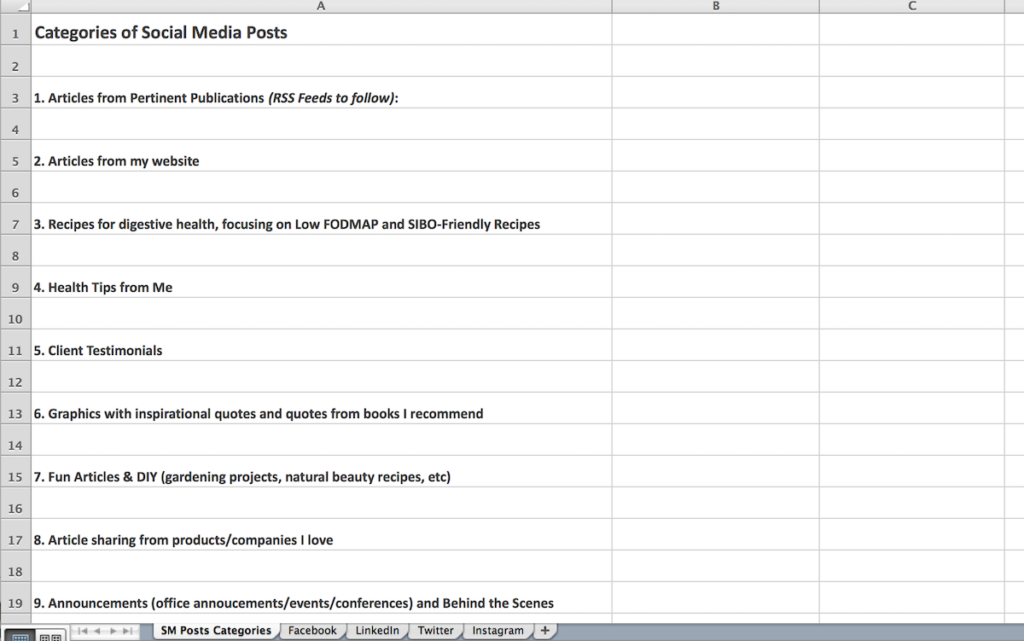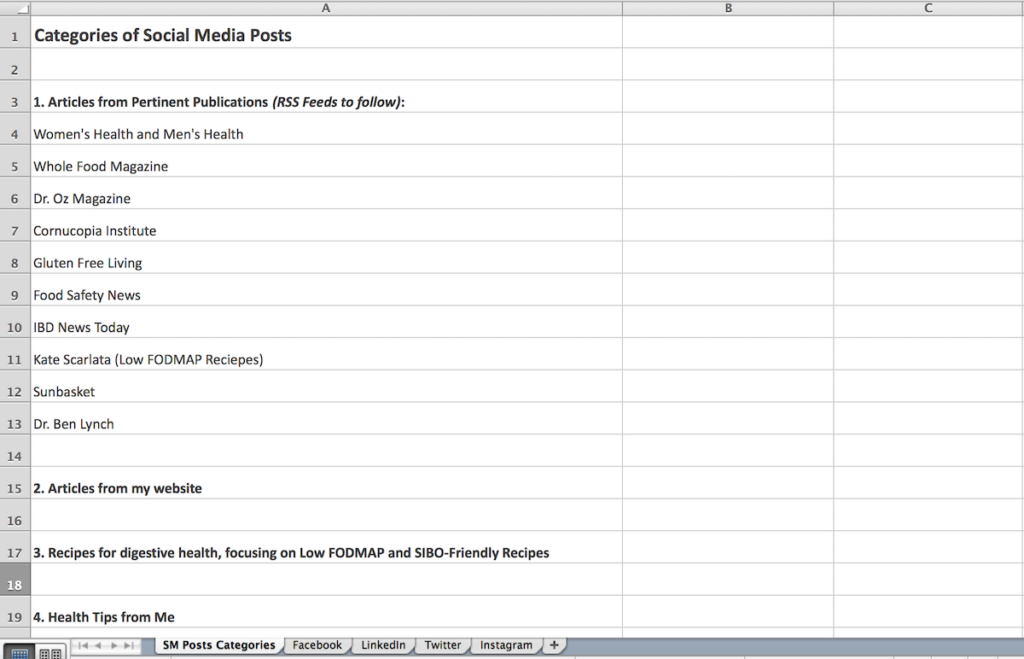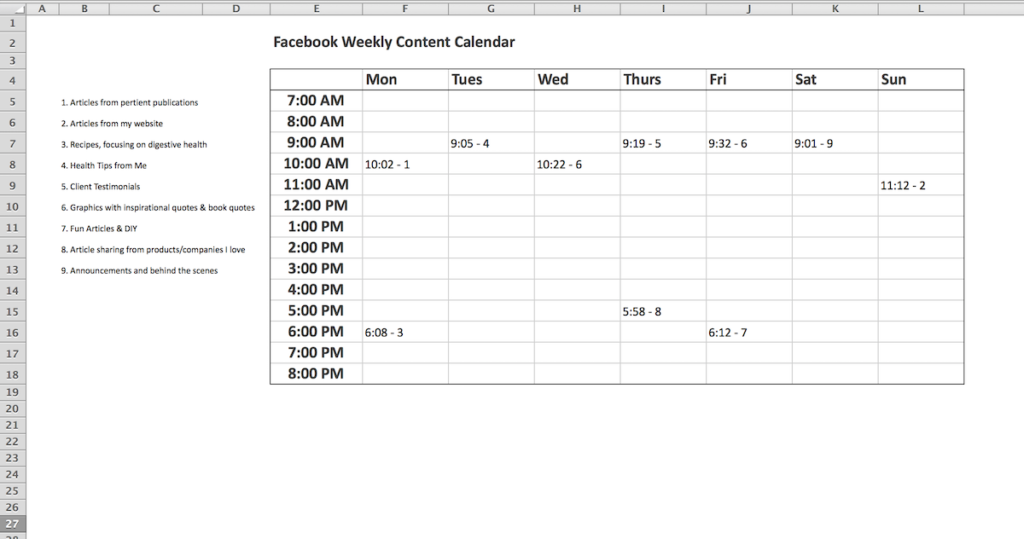
In my experience, health practitioners tend to have a love–hate relationship with social media.
And with good reason!
Don’t get me wrong–there’s a lot to love about social media as a relationship-building and value-based marketing platform. It provides a way for you to connect with prospective clients and build a wider audience, it helps people get to know, like, and trust you as a practitioner, and it even improves the SEO of your website.
But then there are the frustrating elements. The most common concerns I hear from practitioners are that they’re unsure how it’s helping their business, they feel like there are too many platforms to manage easily, they’re not sure what to post, and, most of all, that it is time consuming. When you’re a one-(wo)man show, as so many of us holistic practitioners are, it’s not easy to find the time to dream up endless streams of content to post.
Which is why I am a huge fan of social media editorial calendars.
Here’s what a social media editorial calendar is
An editorial calendar is basically just an eloquent way of saying: a plan for what you’re going to post, and when you’re going to post it.
The beauty of creating an editorial calendar for your social media is that it provides you with a repeatable framework for managing your social platforms. Repeatable framework = less stress, less inefficiency, and more time for you to work on the many parts of your business that are not social media.
Having a social media calendar can actually help make social media fun because it takes away the oppressive feeling of overwhelm. Rather than staring at a blank screen and wondering what to write, your calendar provides you with a solid plan of action.
Let’s dig into how you can create your own.
How to create your social media editorial calendar
Step 1: Create your list of categories
With this step, we’re identifying what categories of content your audience would be interested in. This helps us ensure that what we’re sharing on our channels is interesting, engaging, and relevant. It also helps us break down this broad concept of “content creation” into bite-sized pieces, so that it becomes easier for us to tackle.
Social media is meant to be, well, social. We don’t justwant to link to scientific articles on our social platforms and we certainly don’t justwant to promote our services or ourselves. We want to provide content that educates, interests, engages, and inspires our social audience. By providing this mix of content from a variety of categories, your social feeds will be more effective and engaging for those you’re trying to connect with.
Here’s an exercise for finding your content categories:
- List 5 topics that are directly related to your ideal client’s primary challenges
(This is how we’re going to identify what kind of articles, tips, and educative information we should be focusing on)
- List 5 topics your ideal client would find entertaining, interesting, or inspiring
(This helps us think of the “fun” stuff we can include on our social platforms, while still being relevant to our audience)
- List 5 successful social media profiles where your ideal client is currently spending their time (such as Facebook pages, Instagram profiles, or Twitter feeds)
(This helps you evaluate what you like, or don’t like, about what other people are doing on their social channels in the wellness space, and also gives you places to share content from that your audience would enjoy)
- List 10 blogs or online publications that would be pertinent, helpful, and interesting to your ideal client
(This provides you with a places you can share content from that you know would be valuable for your audience)
- List your upcoming promotions, announcements, and specials
(You do want to make sure you’re also encouraging people to work with you!)
Example of Step 1 in action
As an example, if your ideal client is a professional woman in her 30s with autoimmune issues, the topics that are directly related to her primary challenges could be:
- Digestive health
- Energy issues
- Organic recipes and foods
- Meal planning
- Desire for quick, practical tips and info to help with her condition
For this same ideal client, the topics she might find interesting, entertaining, or inspiring could be:
- Organic and natural beauty products
- Exercise (such as spinning, yoga, or hiking)
- Meal planning
- Non-toxic cleaning solutions
- Inspirational quotes
Social profiles where she might be spending her time could include:
- MindBodyGreen
- Autoimmune Wellness
- Isabella Wentz
- Dr. Axe
- Wellness Mama
Examples of blogs or publications that they are either currently reading or would be interested in and benefit from could include:
- MindBodyGreen
- Autoimmune Wellness
- Isabella Wentz
- Dr. Axe
- Wellness Mama
- Oz
- Whole Food Magazine
- Women’s Health
- Gluten-Free Living
- The Paleo Mom
And from this exercise, we can create our content categories. Here’s an example list we can create from our example ideal client above:
- Articles from pertinent publications we’ve listed
- Articles or recipes from your own website
- Recipes that support autoimmunity
- Quick health tips from you
- Article sharing from products/companies you love
- Fun, interesting articles (on topics like organic makeup or nontoxic cleaning)
- Inspirational quotes
- Client testimonials
- Promotions, announcements, and behind-the-scenes (such as in your office)
Step 2: Decide when you’re going to post from those categories
Now that you’ve established your categories, it’s time to decide what days and times you’d like to share them.
For example, your quick health tips might come every Monday at 9 am, while your recipes might be posted on Wednesdays at 6 pm.
You don’t have to post from every category every week. If you’re only posting 3-4 times per week, you could set up a bi-weekly or monthly calendar and spread the categories out over a period of 2 (or more) weeks.
Step 3: Gather this information into some kind of calendar system
Personally, I’m a fan of a good, old-fashioned spreadsheet for managing my editorial calendar.
I like how I can have a separate tab that lists all of my content categories, as well as a separate tab for each social media profile all in the same Excel file.
Here’s a visual example of how I do it:

You can also include your go-to sites and resources right in your category sheet:

Next come the calendars themselves:

If you like this method, you’re welcome to download this template here.
Step 4: Gather content for each category and store it somewhere
Personally, I am ALSO a fan of a good, old-fashioned spreadsheet for content storing.
I like having separate tabs for each category, and writing the content directly into the spreadsheet. This way, I can also repurpose articles and updates that I liked in the following months or years. Social updates have a lifespan of <just a few hours>[http://www.copypress.com/blog/lifespan-social-media-content/], so it’s ok to share the same content again!
And that’s it! That’s all you need to create your very own social media editorial calendar.
Regardless of whether you’re using a social media scheduling tool to get those posts out or posting them natively right inside the platform, using this process to plan out your social posting schedule will streamline your social posting immensely.
As a final tip: set aside a dedicated social media afternoon and knock out this editorial calendar creation business all at one go. Dragging the process out makes it seem harder than it actually is, and if you can commit just a few dedicated hours to it, you can have your upcoming social content all taken care of and get back to the business of helping people.
Download your social media editorial calendar template here and dig in!
 With love and support,
With love and support,





